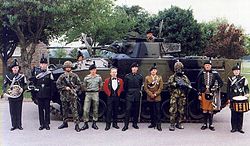History
Creation
The Royal Irish Rangers came into being on 1 July 1968 through the amalgamation of the three regiments of the North Irish Brigade: the Royal Inniskilling Fusiliers, the Royal Ulster Rifles and the Royal Irish Fusiliers. [1] The date was initially known as "Vesting Day" (and then "Rangers Day"), emphasising that the traditions of the old regiments were "vested" in the new large regiment. [1] Soon after creation in December 1968, and as part of a general reduction in the Army, the 3rd Battalion (former Royal Irish Fusiliers) was disbanded. [2] The three regiments had old and differing traditions (Rifle and Fusilier) and to avoid favouring one above another, the unique designation "Rangers" was adopted. The title had not existed in the British Army since 1922. [1] With the creation of the "Divisions of Infantry", the Royal Irish Rangers became part of the King's Division, along with regiments from the north of England. [3]
Deployments
The 1st Battalion moved to Barrosa Barracks in Hemer, Germany in September 1970 from where units were deployed to Cyprus on peacekeeping duties in November 1971. [4] The battalion returned home in July 1974 where it was stationed in Battlesbury Barracks in Warminster it became the infantry demonstration Battalion. Two years later it moved to RAF Little Rissington in the Cotswolds, before being sent to Berlin in May 1979. [4] After returning home in April 1981 the battalion moved to Chester bfor 2 yrs before moving to Belfast Barracks in Osnabrück in January 1985. [4] The battalion undertook a deployment to Northern Ireland during the Troubles in September 1988. [4]
The 2nd Battalion, which had been based in Gibraltar on formation, returned home in October 1969. [4] It moved to Barrosa Barracks in Hemer in July 1974 from where it deployed to Cyprus in January 1975. [4] After returning home in March 1979, it moved to Wavell Barracks in Berlin in October 1981 and back to England in March 1983. [4] It deployed to Cyprus in May 1985 and to the Falkland Islands in March 1987. [4]
Music of the regiment
The Regimental Quick March is Killaloe. It was written around 1887 by an Irish composer, Robert Martin, for the London Musical "Miss Esmeralda". [10] The lyrics relate the story of a French teacher attempting to make himself understood to a difficult Killaloe class. Originally in 2
4 time, it was made well known in military circles by a cousin of the composer - Lt. Charles Martin of the 88th Connaught Rangers (The Devil's Own). He composed new lyrics, in 6
8 time, celebrating his Regiment's fame. No mention is made of the tune in the Regimental history, but there is an explanation that may account for the shout or yell in the military version of Killaloe. [10]
Historically, in the 1st Battalion (Connaught Rangers), formerly the 88th, a favourite march tune was "Brian Boru" played when marching through a town - often after a hot and heavy march. On such occasions, and at a time given by the sergeant major, the band would pause and all ranks would give a "Connaught yell". The march became popular among the other Irish regiments and various other sets of lyrics were devised. On parade, soldiers of the Royal Irish Rangers gave a spine-tingling "Ranger yell"; this continues with the Royal Irish Regiment. [10]
The first known recording of Killaloe was made by Richard Dimbleby when serving as a BBC war correspondent in Northern France shortly before Dunkirk. The "Famous Irish Regiment" Dimbleby reports playing as they march past is not named, but would have been either the Royal Irish Fusiliers or the Royal Inniskilling Fusiliers. [10]
Again in 1944, the BBC recorded the 1st Battalion, Royal Inniskilling Fusiliers Pipes & Drums playing Killaloe, by then adopted unofficially as the march of the 38th (Irish) Brigade, during the approach to Monte Cassino. Killaloe was adopted by the Royal Irish Rangers on its formation and again later by the Royal Irish Regiment on its amalgamation in 1992. [10]
Lyrics
The soldiers often put their own words to the tune which would be sung, sotto voce , as they marched: [11]
(Oh) We're the Irish Rangers,
The boys who fear no danger,
We're the boys from Paddy's land
YO!
Shut up you bugger s and fight
This page is based on this
Wikipedia article Text is available under the
CC BY-SA 4.0 license; additional terms may apply.
Images, videos and audio are available under their respective licenses.
